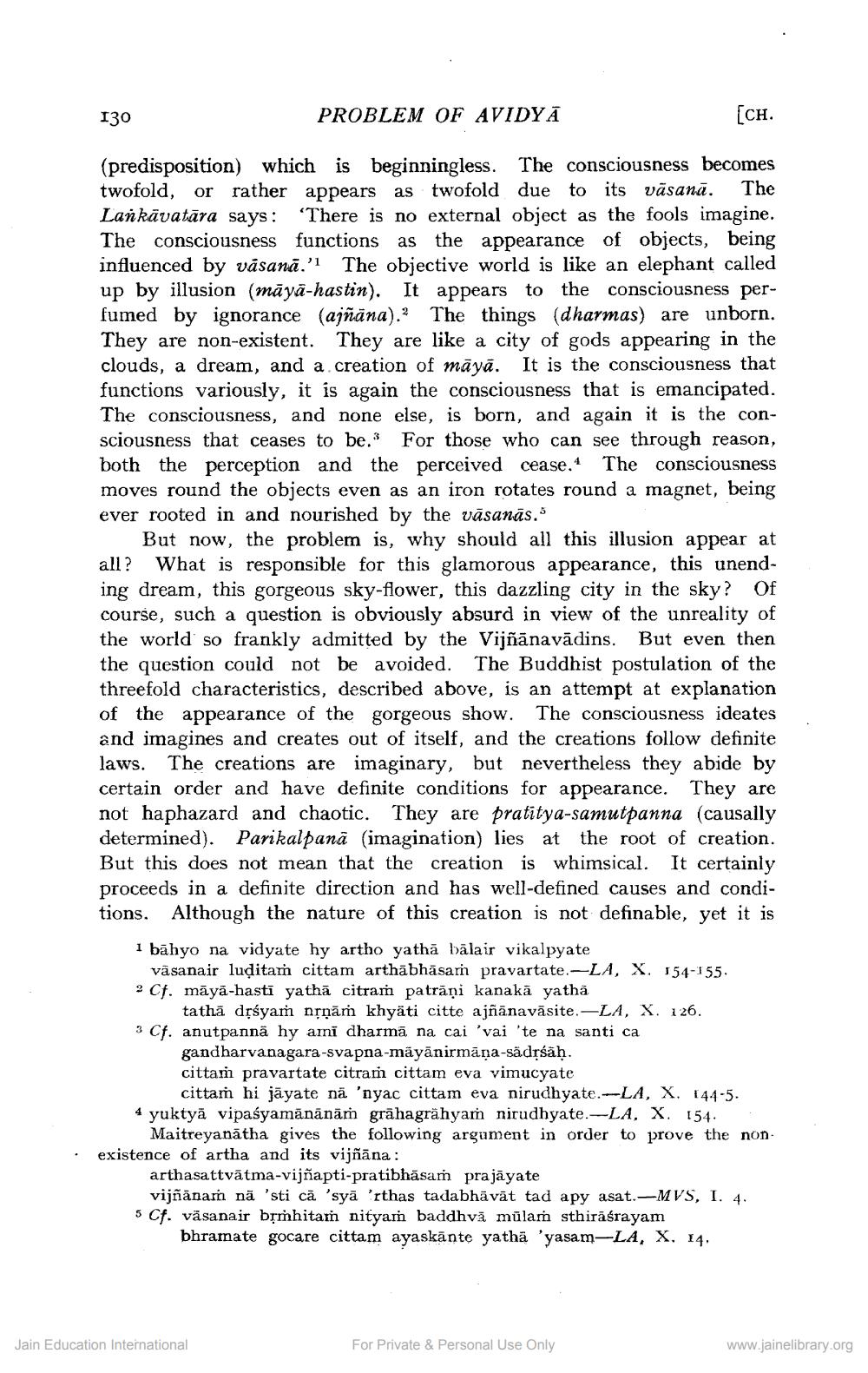________________
[CH.
(predisposition) which is beginningless. The consciousness becomes twofold, or rather appears as twofold due to its vāsanā. The
Lankavatara says: "There is no external object as the fools imagine. The consciousness functions as the appearance of objects, being influenced by vāsanā."1 The objective world is like an elephant called up by illusion (māyā-hastin). It appears to the consciousness perfumed by ignorance (ajñāna). The things (dharmas) are unborn. They are non-existent. They are like a city of gods appearing in the clouds, a dream, and a creation of maya. It is the consciousness that functions variously, it is again the consciousness that is emancipated. The consciousness, and none else, is born, and again it is the consciousness that ceases to be." For those who can see through reason, both the perception and the perceived cease.1 The consciousness moves round the objects even as an iron rotates round a magnet, being ever rooted in and nourished by the vasanās.5
But now, the problem is, why should all this illusion appear at all? What is responsible for this glamorous appearance, this unending dream, this gorgeous sky-flower, this dazzling city in the sky? Of course, such a question is obviously absurd in view of the unreality of the world so frankly admitted by the Vijñānavādins. But even then the question could not be avoided. The Buddhist postulation of the threefold characteristics, described above, is an attempt at explanation of the appearance of the gorgeous show. The consciousness ideates and imagines and creates out of itself, and the creations follow definite laws. The creations are imaginary, but nevertheless they abide by certain order and have definite conditions for appearance. They are not haphazard and chaotic. They are pratitya-samutpanna (causally determined). Parikalpana (imagination) lies at the root of creation. But this does not mean that the creation is whimsical. It certainly proceeds in a definite direction and has well-defined causes and conditions. Although the nature of this creation is not definable, yet it is
130
PROBLEM OF AVIDYA
1 bahyo na vidyate hy artho yathā bālair vikalpyate
vāsanair luḍitam cittam arthābhāsam pravartate.-LA, X. 154-155.
2 Cf. māyā-hasti yatha citram patrāņi kanaka yathā
tatha dṛśyam nṛṇam khyäti citte ajñānavāsite.-LA, X. 126.
3 Cf. anutpanna hy ami dharma na cai 'vai 'te na santi ca gandharvanagara-svapna-māyānirmāṇa-sädṛśaḥ.
cittam pravartate citraṁ cittam eva vimucyate
cittam hi jāyate na 'nyac cittam eva nirudhyate.-LA, X. 144-5. 4 yuktya vipaśyamānānāṁ grähagrähyam nirudhyate.-LA, X. 154. Maitreyanatha gives the following argument in order to prove the nonexistence of artha and its vijñāna:
arthasattvātma-vijñapti-pratibhasam prajayate
vijñānaṁ nā 'sti ca 'sya 'rthas tadabhāvāt tad apy asat.-MVS, I. 4. 5 Cf. väsanair bṛmhitam nityaṁ baddhvā mūlaṁ sthirāśrayam bhramate gocare cittam ayaskante yatha 'yasam-LA, X. 14.
Jain Education International
For Private & Personal Use Only
www.jainelibrary.org




